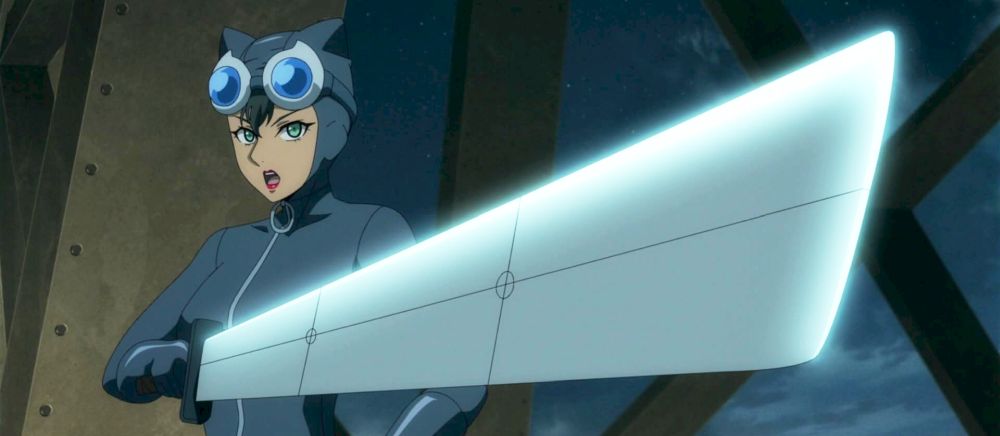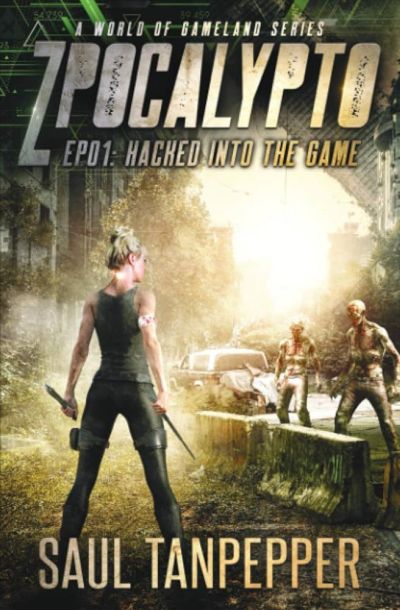 ★★
★★
“A cat-aclysmic cat-astrophe!”
Catwoman: Hunted is a 2022 DC animated movie. Here is a little confession: Catwoman alone never worked for me. In combination with Batman, there is that special chemistry, a feeling that makes the character work but alone? Nope! Neither in the comics with her solo title, nor in a movie solely focused on her (Catwoman with Halle Berry still makes me tremble… but not in a good way!) does this character function for me. A burglar dressed in a cat-suit? No, actually that comes across for me as old-fashioned (do thieves that climb up houses still exist, today?). Strangely, whenever the character appears on the screen contrasted with Batman, it works.
Anyway, it doesn’t stop people from trying to give the most famous Cat-orientated character of the DC universe further solo adventures. In this movie, Selina Kyle appears in classical dress at some kind of cosplay event. Everyone is dressed either as a DC hero or villain: she is next to Batman villain Black Mask in her classic 1940s costume, only to later switch into her modern sexy suit and steal a diamond. Unfortunately, she is discovered and hunted by the Leviathan crime syndicate that set up the party. The diamond was Black Mask’s entry fee to the society. Catwoman is saved by Batwoman who kind of forces her to do… well, what? Kind of spying on Leviathan. Once again being discovered – for a thief she is really not that successful – she and Batwoman must face several opponents…
 What sounds as if it could be an interesting story, turned out to be a very disappointing movie. I had to watch it twice because even though the film is a short 78 minutes, I almost fell asleep. The introduction to the story feels clumsily handled, scenes are overlong, and after we know where the story wants to go, the movie basically is a constant follow-up of fight scenes of Catwoman and Batwoman against a range of well-known and lesser known DC villains. These include Cheshire, Nosferata (one I had never heard of before, and I used to read DC comics quite regularly in my youth), Solomon Grundy and the Cheetah herself, Barbara Minerva who is Leviathan’s chairwoman, though Talia al Gul is managing everything from the shadows.
What sounds as if it could be an interesting story, turned out to be a very disappointing movie. I had to watch it twice because even though the film is a short 78 minutes, I almost fell asleep. The introduction to the story feels clumsily handled, scenes are overlong, and after we know where the story wants to go, the movie basically is a constant follow-up of fight scenes of Catwoman and Batwoman against a range of well-known and lesser known DC villains. These include Cheshire, Nosferata (one I had never heard of before, and I used to read DC comics quite regularly in my youth), Solomon Grundy and the Cheetah herself, Barbara Minerva who is Leviathan’s chairwoman, though Talia al Gul is managing everything from the shadows.
It feels as if someone threw as many characters, mainly female ones, into the script as possible, perhaps to hide the fact that Batman isn’t in the picture. But they don’t necessarily have the knowledge how these characters usually act. That may be partly the fault of director Shinsuke Terasawa (Wikipedia lists the movie as a Japanese-American production; maybe Warner’s wanted to save money?) but the script also has structure problems. What I’d call act one wasn’t finished until half the film’s running time was over. And the script doesn’t develop any further from this point on. You’re left to wonder what the big plan was, or what Catwoman was supposed to do, but this question is never answered. The remainder is a bunch of fight scenes, heaped on each other until this is finally over.
The script is by Greg Wiseman, whom I personally admire for his wonderful, unfortunately underrated, Disney animated classic series Gargoyles from the late 90s. He also was involved in animated series such as The Spectacular Spider-Man and Young Justice, a series that also has its fans, despite flying under the radar. But here he seems missing the right feel for the established DC heroes and villains.
Take the Catwoman of this film for example. We all know how this character should be played, though there are different interpretations of the character on the big screen over the years. This Catwoman comes across as downright awkward and arrogant to the hilt. We know of Catwoman’s erotic flirtations with Batman, but here she is “in heat” the whole time which just feels wrong. I know how it sounds but this Catwoman feels… well… oversexualized. And just because she has a thing for Batman doesn’t mean you just can switch this behaviour to Batwoman. Yes, we know Batwoman is nowadays a lesbian, since this side-character from the Batman comics of the 50s was resurrected in modern times. But that doesn’t mean that she must almost be seduced by Catwoman. Then Catwoman drops the ball again, as if the whole point of the scene was just about showing us how incredibly irresistible she is to everyone. Thank you very much, female self-esteem!
More than this – and difficult even for me, who usually accepts some very unbelievable things in story-telling – this Catwoman seems almost to have superpowers. I have no problem having her, teamed with Batwoman, fighting the assassin Cheshire, against whose poison she had earlier taken an antidote, or Nosferata, who reminded me of a female version of classic character Man-Bat. But the two fighting and beating 50+ assassins of the League of Shadows? No. Just no. Sometimes it borders on the ridiculous. When Catwoman shoves a bundle of explosives in Solomon Grundy’s mouth and tells us: “That’s all folks!”, I wondered who had the marvellously stupid and tonally deaf idea of referencing Porky Pig in a DC movie! It just feels tonally wrong.
 Another ill-fitting decision is the score by Yutaka Yamada. Don’t get me wrong. His music will probably please you if you like jazz, but for a DC action movie it’s just the wrong choice. What almost – but only almost – saves the movie is the final chase when Barbara Minerva turns into an oversized version of her Cheetah personality and goes after Catwoman. For the first time in this movie you have the feeling Catwoman is in real danger. But this is too little too late. It can’t compensate for all the mistakes that had been made in the movie before.
Another ill-fitting decision is the score by Yutaka Yamada. Don’t get me wrong. His music will probably please you if you like jazz, but for a DC action movie it’s just the wrong choice. What almost – but only almost – saves the movie is the final chase when Barbara Minerva turns into an oversized version of her Cheetah personality and goes after Catwoman. For the first time in this movie you have the feeling Catwoman is in real danger. But this is too little too late. It can’t compensate for all the mistakes that had been made in the movie before.
Don’t take the above too hard; someone unaccustomed to DC or Batman comics might actually enjoy this. For me, someone who knows and loves the characters, it felt like a gigantic misstep by the creative team who made this film. And I still can’t help the feeling that it would have been a much better movie if Batman had been the main character, having to deal with an opposing Catwoman. The best thing here was a 40-minute extra on my Blu-Ray, about the history of Catwoman in comics, TV and movies. That was really interesting. The main feature… not so much!
Dir: Shinsuke Terasawa
Star (voice): Elizabeth Gillies, Stephanie Beatriz, Kirby Howell-Baptiste, Zehra Fazal





 The literary rating is mostly down to the sluggish way in which this gets going. Though having subsequently discovered this is the first in a
The literary rating is mostly down to the sluggish way in which this gets going. Though having subsequently discovered this is the first in a  If I see a more relentless and brutal film in 2025, I’m going to be quite surprised. This doesn’t let up, with people being eaten alive, impaled, decapitated and slitting their own throats when they realize the horror of… Well, let’s leave that to the film to divulge, shall we? I must say, you should probably read the first sentence of the Wikipedia synopsis, because there is a lot there, which the film does not explain. Admittedly, this is in part because it contains almost no dialogue, and there are a number of elements which feel near impossible to show, rather than tell. You don’t need to know them to enjoy this. But they will certainly answer some questions.
If I see a more relentless and brutal film in 2025, I’m going to be quite surprised. This doesn’t let up, with people being eaten alive, impaled, decapitated and slitting their own throats when they realize the horror of… Well, let’s leave that to the film to divulge, shall we? I must say, you should probably read the first sentence of the Wikipedia synopsis, because there is a lot there, which the film does not explain. Admittedly, this is in part because it contains almost no dialogue, and there are a number of elements which feel near impossible to show, rather than tell. You don’t need to know them to enjoy this. But they will certainly answer some questions.  What the film has is a mute woman, Azrael (Weaving) and her boyfriend, Kenan (Stewart-Jarrett), getting captured by an equally silent cult in a forest. The time and era is uncertain, but they do have working cars, so it seems fairly contemporary. They want to sacrifice her to dark, humanoid creatures which inhabits the woods, but she is able to escape back into the wilderness. She attempts to return, so she can rescue her boyfriend, and encounters the group’s spiritual leader, the pregnant Miriam (Sonne). After failing to save Kenan, and narrowly escaping from the dark creatures more than once, as well as getting buried alive, Azrael vows to take bloody and fiery revenge on the cult, and also discovers the true nature of Miriam’s pregnancy.
What the film has is a mute woman, Azrael (Weaving) and her boyfriend, Kenan (Stewart-Jarrett), getting captured by an equally silent cult in a forest. The time and era is uncertain, but they do have working cars, so it seems fairly contemporary. They want to sacrifice her to dark, humanoid creatures which inhabits the woods, but she is able to escape back into the wilderness. She attempts to return, so she can rescue her boyfriend, and encounters the group’s spiritual leader, the pregnant Miriam (Sonne). After failing to save Kenan, and narrowly escaping from the dark creatures more than once, as well as getting buried alive, Azrael vows to take bloody and fiery revenge on the cult, and also discovers the true nature of Miriam’s pregnancy.  While I have seen all the movies, I’ve never particularly been a fan of the Star Trek universe. I leave that largely to Chris, who has been watching the show since the original series. That includes Star Trek: Discovery, the series from which this spun off, and I was… in the room when it was on. But I
While I have seen all the movies, I’ve never particularly been a fan of the Star Trek universe. I leave that largely to Chris, who has been watching the show since the original series. That includes Star Trek: Discovery, the series from which this spun off, and I was… in the room when it was on. But I  This low-budget Western does a lot of things right, but is not able to tie up all the loose ends in the final act. Most of which are ends that never needed to be loose in the first place. It takes place in 1890’s Oklahoma, when the gang of George ‘Bittercreek’ Newcomb (Henry) is trying to head back home. The gang includes a female outlaw, Rose Dunn (Butala), who is perhaps a little more moral than some members of the gang e.g. Tom, played by veteran villain Michael Ochotorena, this time covering up his impressive face tattoos. The situation comes to a head after Rose rescues a saloon girl, Ellie (Mattox), who just shot a man dead.
This low-budget Western does a lot of things right, but is not able to tie up all the loose ends in the final act. Most of which are ends that never needed to be loose in the first place. It takes place in 1890’s Oklahoma, when the gang of George ‘Bittercreek’ Newcomb (Henry) is trying to head back home. The gang includes a female outlaw, Rose Dunn (Butala), who is perhaps a little more moral than some members of the gang e.g. Tom, played by veteran villain Michael Ochotorena, this time covering up his impressive face tattoos. The situation comes to a head after Rose rescues a saloon girl, Ellie (Mattox), who just shot a man dead. I guess it’s equality at work. This film, written by, starring and directed by women, proves that they are every bit as capable as men… Of knocking out vaguely competent, forgettable, low-to-mid tier action films, anyway. #GirlBoss This is another in the ongoing series of Tubi Originals I’ve reviewed here, including
I guess it’s equality at work. This film, written by, starring and directed by women, proves that they are every bit as capable as men… Of knocking out vaguely competent, forgettable, low-to-mid tier action films, anyway. #GirlBoss This is another in the ongoing series of Tubi Originals I’ve reviewed here, including  If I’d realized earlier this was by the director of the underwhelming, non-GWG film,
If I’d realized earlier this was by the director of the underwhelming, non-GWG film,  There are reviews which are easy to write, because – good or bad – the subject generates a lot to talk about. This is not one of those. It’s a bland slice of semi-urban fantasy, which just… sits there, the literary equivalent of a bowl of vanilla pudding. It’s not good, nor is it bad enough to be memorable. It merely exists, remarkable mostly in how unremarkable it is. Put it this way, I finished it less than 24 hours ago, and I can’t even remember the heroine’s name, so little impression was made. Instead of writing, I find myself almost preferring the Star Trek musical episode Chris is watching next to me. And I don’t really like Star Trek. Or musical episodes.
There are reviews which are easy to write, because – good or bad – the subject generates a lot to talk about. This is not one of those. It’s a bland slice of semi-urban fantasy, which just… sits there, the literary equivalent of a bowl of vanilla pudding. It’s not good, nor is it bad enough to be memorable. It merely exists, remarkable mostly in how unremarkable it is. Put it this way, I finished it less than 24 hours ago, and I can’t even remember the heroine’s name, so little impression was made. Instead of writing, I find myself almost preferring the Star Trek musical episode Chris is watching next to me. And I don’t really like Star Trek. Or musical episodes.  I was a little nervous on reading the IMDb trivia section: “Three motorcycle clubs participated as extras and offered technical advice.” If this sucked and I gave it a bad review, would I get a visit from a group of annoyed bikers, offering me ‘technical advice’ with a wrench? Turns out I needn’t have worried. While low-budget by Hollywood standards, it has some interesting ideas, and the execution is competent enough to pass muster. The events here take place after the collapse of the United States, when everywhere West of the Mississippi has basically been left to fend for itself. In this part of Nevada, that means two biker gangs, the Skoners and the Gypsies are fighting for control.
I was a little nervous on reading the IMDb trivia section: “Three motorcycle clubs participated as extras and offered technical advice.” If this sucked and I gave it a bad review, would I get a visit from a group of annoyed bikers, offering me ‘technical advice’ with a wrench? Turns out I needn’t have worried. While low-budget by Hollywood standards, it has some interesting ideas, and the execution is competent enough to pass muster. The events here take place after the collapse of the United States, when everywhere West of the Mississippi has basically been left to fend for itself. In this part of Nevada, that means two biker gangs, the Skoners and the Gypsies are fighting for control. Reaching the summit of Mount Everest once is a remarkable achievement, done by only a few thousand people in history, with hundreds having died in the attempt. But what about climbing the world’s highest peak on no less than
Reaching the summit of Mount Everest once is a remarkable achievement, done by only a few thousand people in history, with hundreds having died in the attempt. But what about climbing the world’s highest peak on no less than